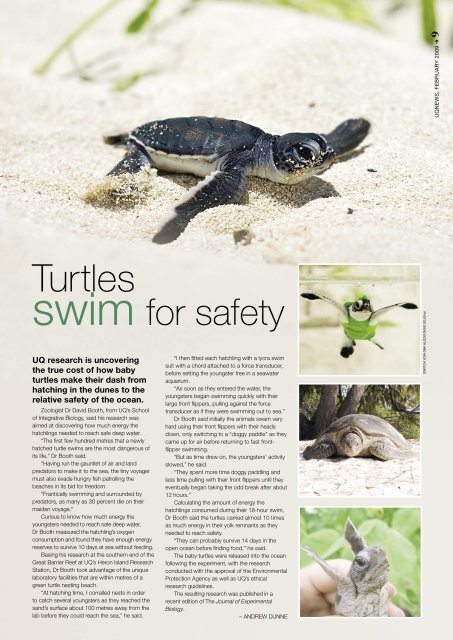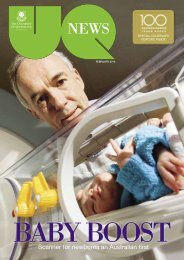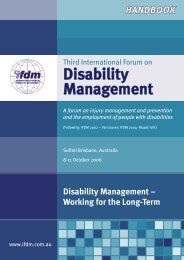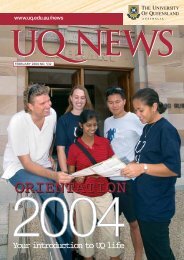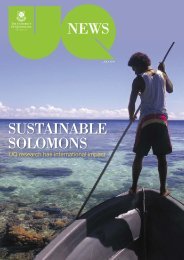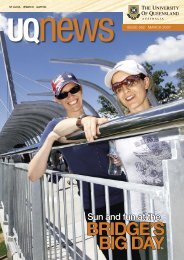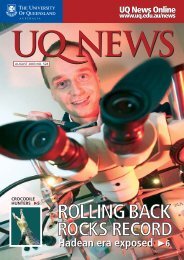UQNEWS, FEBRUARY 2009 ➔ 8SEAN FITZGIBBON PHOTOS STEWART GOULDDeadline for dengueA mosquito-borne virus that eachyear harms up to 100 million people<strong>and</strong> kills more than 20,000 is a stepcloser to being controlled after abreakthrough by UQ scientists.In a paper published in the prestigiousinternational journal Science in January, theresearchers have proven the effectiveness <strong>of</strong> anew way <strong>of</strong> limiting the lifespan <strong>of</strong> the type <strong>of</strong>mosquito that spreads dengue fever.They have done it by infecting the denguemosquito, Aedes aegypti, with a bacterium thatis harmless to humans <strong>and</strong> other animals buthalves Aedes’ lifespan. This has theORPHANED KOALABECOMES MOTHERAn orphaned baby koala that wasflown 1200km to be raised in captivityhas recently become a first-time mum,following her successful return to thewild.In August 2005, the tiny five-month oldkoala named Shirley was found on a propertynear the Blair Athol Coal Mine in CentralQueensl<strong>and</strong> <strong>and</strong> was rushed to the MoggillKoala Hospital in Brisbane.potential to greatly reduce dengue becauseonly old mosquitoes are effective at transmittingthe virus to humans.Carried out in the lab <strong>of</strong> Pr<strong>of</strong>essor ScottO’Neill (pictured), the experiment’s involvedpainstaking work with the Aedes mosquito <strong>and</strong>Wolbachia, a bacterium that occurs in fruit flies.PhD student Conor McMeniman usedsuper-fine needles to manually inject 10,000mosquito embryos with Wolbachia, <strong>and</strong>encouraged the surviving mosquitoes to feedon his own blood.“We ended up having to inject thous<strong>and</strong>s <strong>of</strong>embryos to achieve success, butit was well <strong>and</strong> truly worth it in theend,” Mr McMeniman said.Pr<strong>of</strong>essor O’Neill saidthe project’s next stagewould be a contained fieldcage setting in northernQueensl<strong>and</strong>.The scientists’ successis critical to the progress <strong>of</strong>a $10 million project fundedby the Bill <strong>and</strong> MelindaGates Foundation <strong>and</strong> maylead to a new, safe <strong>and</strong>cheap way <strong>of</strong> curtailing thevirus.A year later Shirley was returned to the wild,but not before Dr Sean FitzGibbon, from UQ’sCentre for Mined L<strong>and</strong> Rehabilitation, fittedher with a radio-transmitting collar so he couldmonitor the success <strong>of</strong> her release.On a field visit last year, Dr FitzGibbonspotted Shirley curled up in a gum tree, <strong>and</strong>found an extra surprise.“There was another pair <strong>of</strong> eyes lookingdown on me. Shirley has had a baby,” he said.“The fact that Shirley has come full circle <strong>and</strong>now has young indicates that her rehabilitationto the wild has been extremely successful.“So many people worked as a team tokeep Shirley alive <strong>and</strong> now that she is a firsttimemother we know it has all beenworthwhile.”Fortunately for Shirley, her rescuer, anemployee at the Blair Athol Coal Mine, hadspent years working alongside scientistsfrom Koala Venture, a collaborationbetween UQ <strong>and</strong> Rio Tinto.Established in the early 1990s, KoalaVenture is the longest running koalamonitoring program in Australia <strong>and</strong> hasuncovered information about the life cycle<strong>of</strong> koalas, their dietary preferences <strong>and</strong>breeding behaviours.Researchers work with Rio Tinto toensure mining activities are performed ina way which reduces negative impactsupon koalas <strong>and</strong> facilitates the restoration<strong>of</strong> suitable habitats.Shirley, who is now living happilyin Central Queensl<strong>and</strong> with her joey,Pepper, is just one Koala Venturesuccess story.INFO ➔ To learn more about theproject, visit www.koalaventure.comEXHIBITION OPENSA new exhibit featuring morefossils <strong>of</strong> the world’s first moderncrocodilian has opened in Isisford,central-western Queensl<strong>and</strong>.UQ palaeontologist Dr Steve Salisbury,who with his team have been spearheadingthe research in Isisford since 2001, saidthe exhibit was an extension <strong>of</strong> the existingdisplay that was first unveiled in 2006, atthe Outer Barcoo Interpretation Centre.“Our goal with this display was to sharewith the public the processes behind thescience <strong>of</strong> palaeontology,” Dr Salisbury said.“Everything from how we find fossilsin the field, gradually expose the bones inthe lab, <strong>and</strong> then interpret their scientificsignificance is shown in the new display.”He said the centrepiece is the completeskull <strong>of</strong> Isisfordia duncani, which wasuncovered after more than 1200 hours <strong>of</strong>drilling work by research assistant KerryGeddes (pictured).“The end result is spectacular asit’s easily the most complete <strong>and</strong> bestpreservedfossil crocodilian skull everdiscovered in Australia. It’s hard to believethat the animal to which it belonged hasbeen dead for almost 100 million years,” DrSalisbury said.INFO ➔ www.isisford.qld.gov.auPHOTOS CARL WARNER AND ANTHONY O’TOOLE
UQNEWS, FEBRUARY 2009 ➔ 9Turtlesswim for safetyUQ research is uncoveringthe true cost <strong>of</strong> how babyturtles make their dash fromhatching in the dunes to therelative safety <strong>of</strong> the ocean.Zoologist Dr David Booth, from UQ’s School<strong>of</strong> Integrative Biology, said his research wasaimed at discovering how much energy thehatchlings needed to reach safe deep water.“The first few hundred metres that a newlyhatched turtle swims are the most dangerous <strong>of</strong>its life,” Dr Booth said.“Having run the gauntlet <strong>of</strong> air <strong>and</strong> l<strong>and</strong>predators to make it to the sea, the tiny voyagermust also evade hungry fish patrolling thebeaches in its bid for freedom.“Frantically swimming <strong>and</strong> surrounded bypredators, as many as 30 percent die on theirmaiden voyage.”Curious to know how much energy theyoungsters needed to reach safe deep water,Dr Booth measured the hatchling’s oxygenconsumption <strong>and</strong> found they have enough energyreserves to survive 10 days at sea without feeding.Basing his research at the southern end <strong>of</strong> theGreat Barrier Reef at UQ’s Heron Isl<strong>and</strong> ResearchStation, Dr Booth took advantage <strong>of</strong> the uniquelaboratory facilities that are within metres <strong>of</strong> agreen turtle nesting beach.“At hatching time, I corralled nests in orderto catch several youngsters as they reached thes<strong>and</strong>’s surface about 100 metres away from thelab before they could reach the sea,” he said.“I then fitted each hatchling with a lycra swimsuit with a chord attached to a force transducer,before setting the youngster free in a seawateraquarium.“As soon as they entered the water, theyoungsters began swimming quickly with theirlarge front flippers, pulling against the forcetransducer as if they were swimming out to sea.”Dr Booth said initially the animals swam veryhard using their front flippers with their headsdown, only switching to a “doggy paddle” as theycame up for air before returning to fast frontflipperswimming.“But as time drew on, the youngsters’ activityslowed,” he said.“They spent more time doggy paddling <strong>and</strong>less time pulling with their front flippers until theyeventually began taking the odd break after about12 hours.”Calculating the amount <strong>of</strong> energy thehatchlings consumed during their 18-hour swim,Dr Booth said the turtles carried almost 10 timesas much energy in their yolk remnants as theyneeded to reach safety.“They can probably survive 14 days in theopen ocean before finding food,” he said.The baby turtles were released into the oceanfollowing the experiment, with the researchconducted with the approval <strong>of</strong> the EnvironmentalProtection Agency as well as UQ’s ethicalresearch guidelines.The resulting research was published in arecent edition <strong>of</strong> The Journal <strong>of</strong> ExperimentalBiology.– ANDREW DUNNEPHOTOS DAVID BOOTH AND NICK HOLMES


